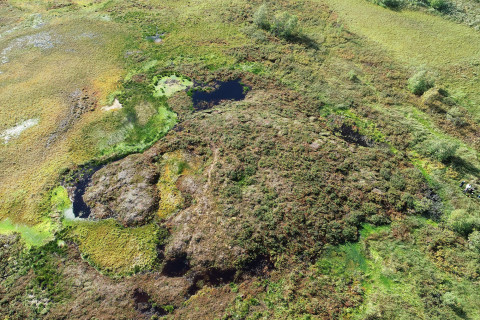A long-term study conducted at the University of Eastern Finland shows a significant reduction in palsa area due to climate change. At the observation sites, palsa area had decreased by more than 75% from 1959 to 2021. However, climate had only a limited impact on the active layer of palsa mounds. Active layer thickness did not significantly increase during the monitoring period, although the lowering and collapse from the edges of palsas indicates that their permafrost core continues to thaw, year after year.
“In one of the observation sites, active layer thickness has in fact been significantly decreasing over the past eight years. This means that permafrost thawing doesn’t necessarily lead to the deepening of the active layer,” says first author, Doctoral Researcher Mariana Verdonen of the University of Eastern Finland, who analysed the data.
Palsa mires found in the northernmost peatlands of Lapland are the main permafrost landforms in Fennoscandia. As the climate warms, palsa mires are expected to disappear and no new palsas have been observed to form. Active layer thickness is one of the most important parameters for monitoring permafrost conditions. Underlain by permafrost, the active layer consists of soil or peat that thaws in the summer and freezes in the winter. As the active layer deepens, the previously frozen organic matter thaws, increasing carbon dioxide and nitrous oxide emissions from the palsa mire. With the climate warming, this thawed layer above permafrost has become deeper in most areas where permafrost occurs.
Published in The Cryosphere, the study monitored the development of two palsa sites in the Kilpisjärvi area in the north-western part of Finnish Lapland, since 2007. Data for the study were collected using high accuracy GNSS devices and active layer measurements as part of an annual field course organised by the University of Eastern Finland.
“It is very rewarding to see the 14 years of data we’ve collected with students now published in a high-ranking journal. This kind of a time series cannot be collected in short-term research projects that typically last for only three or four years,” says Professor Timo Kumpula of the University of Eastern Finland, who initiated the study.
The researchers also used old aerial photographs from 1959, 1985, 2000 and 2012, as well as annual unoccupied aerial system surveys conducted in 2016–2021. The study compared the active layer measurement time series and annual changes in palsa area with different climate parameters, such as air temperature, precipitation and snow cover.
Later onset of snow cover has a surprising effect on active layer thickness
Climate change affects the timing, thickness and duration of snow cover. The warmer the autumn, the longer it takes for the ground to be covered by lasting snow. Later onset of lasting snow cover reduced active layer thickness in the palsa sites.
“This shows the multitude of effects climate change can have on permafrost. One could conclude that warmer autumns would be good for permafrost underneath palsas, but this is not the case because a thin active layer doesn’t mean stable permafrost in palsa mires,” Verdonen emphasises.
Photo by Timo Kumpula: Drone footage taken in the Peera palsa site in Enontekiö, Finnish Lapland, in August 2022.
For further information, please contact:
Doctoral Researcher Mariana Verdonen, tel. +358 50 568 9783, mariana.verdonen(at)uef.fi
Professor Timo Kumpula, tel. +358 50 372 8566, timo.kumpula(at)uef.fi, UEF Connect https://uefconnect.uef.fi/en/person/timo.kumpula/
Research article:
Mariana Verdonen, Alexander Störmer, Eliisa Lotsari, Pasi Korpelainen, Benjamin Burkhard, Alfred Colpaert and Timo Kumpula. Permafrost degradation at two monitored palsa mires in north-west Finland. The Cryosphere, 17, 1803–1819, 2023. https://doi.org/10.5194/tc-17-1803-2023

